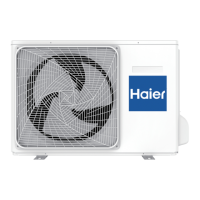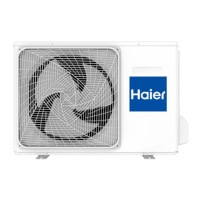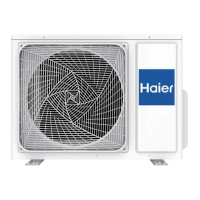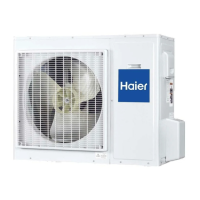Why does my Haier 1U25S2SQ1FA show a suction temperature sensor failure?
- DDenise MartinezAug 2, 2025
A suction temperature sensor failure in your Haier Air Conditioner might be due to incorrect wiring or poor connection of the compressor.
Why does my Haier 1U25S2SQ1FA show a suction temperature sensor failure?
A suction temperature sensor failure in your Haier Air Conditioner might be due to incorrect wiring or poor connection of the compressor.
Cautions for installation and handling to prevent minor injuries or damage.
Compliance information for European regulations like CE and RoHS.
Details on the R32 refrigerant used and related information.
Procedures for safe handling during loading and unloading operations.
Guidelines for managing transport of air conditioning units.
Conditions for storing air conditioning equipment safely.
Specific warnings related to the installation process.
General awareness and procedures to minimize risks during installation.
Steps for inspecting indoor and outdoor units after unpacking.
Checks for the installation environment to ensure safety and proper function.
Fundamental safety principles to follow during installation work.
Guidelines for safe electrical wiring and connections.
Requirements for personnel performing installation work.
Steps for installing the indoor unit.
Steps for fixing the indoor unit wall panel and arranging piping.
Proper routing of drain hoses, wires, and pipes.
Procedure for charging nitrogen for pressure maintenance and leak detection.
Initial steps for installing the outdoor unit.
Securing the outdoor unit to its support or wall.
Aligning and tightening connecting pipes for the outdoor unit.
Process of removing air and moisture from the refrigeration system.
Methods for detecting leaks in the refrigeration piping.
Inspection and testing after installation.
Checklist of items to verify after installation.
Procedures for performing and checking the unit's initial operation.
Important precautions to observe during maintenance work.
Requirements for certified personnel performing maintenance.
Conditions for a safe and proper maintenance site.
Conditions and arrangements for a proper maintenance site.
Procedures and tools for detecting refrigerant leaks.
General safety rules to follow during maintenance.
Specific items to check and requirements during maintenance.
Procedures for maintaining electrical components safely.
Maintenance guidelines for intrinsically safe components.
Procedures for removal, vacuumizing, welding, and charging refrigerant.
Procedures for scrapping and recovering the unit and refrigerant.
Procedures for safely scrapping the air conditioner unit.
Methods for recovering refrigerant during maintenance or scrapping.
Specific precautions when using units with R32 refrigerant.
Safety checks and considerations before commencing installation.
Safety steps before installation or electrical work.
Precautions to take before the initial test run.
Items to verify before starting the installation process.
List of tools and materials required for installation.
Details on copper pipe types, thickness, and flare dimensions.
Procedures for conducting an air tightness test on the system.
Steps for vacuumizing the refrigeration system.
Guidelines for charging refrigerant into the system.
Actions to take in case of refrigerant leaks.
Information on R32 refrigerant properties and handling.
List of accessories included with the unit for installation.
Criteria for choosing the optimal location for the outdoor unit.
Steps for physically mounting the outdoor unit on a foundation.
Detailed dimensions for outdoor unit mounting and clearances.
Specifications for pipe sizes and connection methods.
Detailed steps for performing the air tightness test.
Step-by-step guide for vacuumizing using a vacuum pump.
Instructions for connecting electrical wiring to the unit.
Guidance on selecting power supply and wire sizes.
Step-by-step process for electrical wiring connections.
Cautions for installation and handling to prevent minor injuries or damage.
Compliance information for European regulations like CE and RoHS.
Details on the R32 refrigerant used and related information.
Procedures for safe handling during loading and unloading operations.
Guidelines for managing transport of air conditioning units.
Conditions for storing air conditioning equipment safely.
Specific warnings related to the installation process.
General awareness and procedures to minimize risks during installation.
Steps for inspecting indoor and outdoor units after unpacking.
Checks for the installation environment to ensure safety and proper function.
Fundamental safety principles to follow during installation work.
Guidelines for safe electrical wiring and connections.
Requirements for personnel performing installation work.
Steps for installing the indoor unit.
Steps for fixing the indoor unit wall panel and arranging piping.
Proper routing of drain hoses, wires, and pipes.
Procedure for charging nitrogen for pressure maintenance and leak detection.
Initial steps for installing the outdoor unit.
Securing the outdoor unit to its support or wall.
Aligning and tightening connecting pipes for the outdoor unit.
Process of removing air and moisture from the refrigeration system.
Methods for detecting leaks in the refrigeration piping.
Inspection and testing after installation.
Checklist of items to verify after installation.
Procedures for performing and checking the unit's initial operation.
Important precautions to observe during maintenance work.
Requirements for certified personnel performing maintenance.
Conditions for a safe and proper maintenance site.
Conditions and arrangements for a proper maintenance site.
Procedures and tools for detecting refrigerant leaks.
General safety rules to follow during maintenance.
Specific items to check and requirements during maintenance.
Procedures for maintaining electrical components safely.
Maintenance guidelines for intrinsically safe components.
Procedures for removal, vacuumizing, welding, and charging refrigerant.
Procedures for scrapping and recovering the unit and refrigerant.
Procedures for safely scrapping the air conditioner unit.
Methods for recovering refrigerant during maintenance or scrapping.
Specific precautions when using units with R32 refrigerant.
Safety checks and considerations before commencing installation.
Safety steps before installation or electrical work.
Precautions to take before the initial test run.
Items to verify before starting the installation process.
List of tools and materials required for installation.
Details on copper pipe types, thickness, and flare dimensions.
Procedures for conducting an air tightness test on the system.
Steps for vacuumizing the refrigeration system.
Guidelines for charging refrigerant into the system.
Actions to take in case of refrigerant leaks.
Information on R32 refrigerant properties and handling.
List of accessories included with the unit for installation.
Criteria for choosing the optimal location for the outdoor unit.
Steps for physically mounting the outdoor unit on a foundation.
Detailed dimensions for outdoor unit mounting and clearances.
Specifications for pipe sizes and connection methods.
Detailed steps for performing the air tightness test.
Step-by-step guide for vacuumizing using a vacuum pump.
Instructions for connecting electrical wiring to the unit.
Guidance on selecting power supply and wire sizes.
Step-by-step process for electrical wiring connections.
| Brand | Haier |
|---|---|
| Model | 1U25S2SQ1FA |
| Category | Air Conditioner |
| Language | English |












